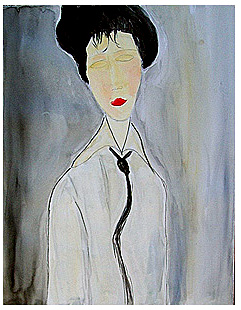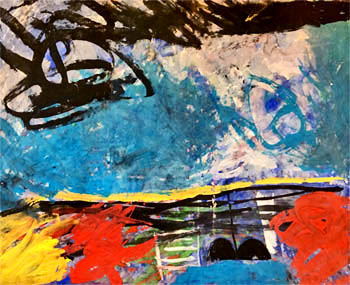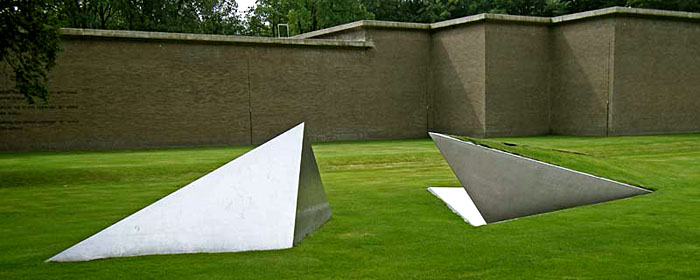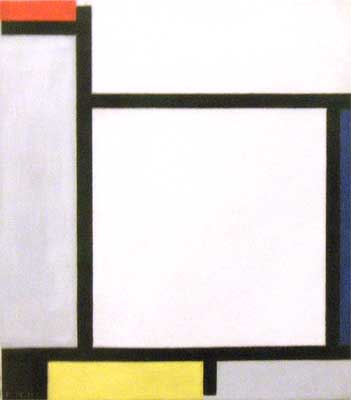About the Outside and Inside of Art
Other Stories aand Articles - Michael's Blog

A week or so ago (August 2017) an episode some 50+ years ago, suddenly came back into my
mind.
It was around 1964, my wife Antien and I had recently married and Antien's
best lady friend Karien had married too, a young artist painter, Vincent Hamel,
living in Amsterdam.
We got together a few times and once or twice went up
to Vincent's studio, which was in the middle of the Amsterdam red light district
("de walletjes").
A narrow front door, flanked on either side by prostitutes sitting behind
their windows, and bathed in soft lighting, cast inviting looks at prospective clients passing by.
Once through the door we immediately climbed a flight of stairs to Vincent's
studio on the upper floor of the building.
In the summer of 1965 we were preparing to move to Australia and got rid of all the
things we did not wish to take with us.
One of these items was a small fridge,
which Vincent and Karien were interested in to take from us. So one day they
came to our house with a folder containing some of Vincent's abstract gouaches and
after some viewing Antien and I selected one of them in exchange for the small
fridge.
 At the end of that year we migrated to Australia, but in 1970 were fortunate enough
to return to Holland for a holiday.
We also met up with Vincent again.
At the end of that year we migrated to Australia, but in 1970 were fortunate enough
to return to Holland for a holiday.
We also met up with Vincent again.
Excitedly he told me
"Michael, I have moved into a totally new direction with my art.
Come to my studio so that I can show it to you."
So I went to see him again in Amsterdam and together we climbed the stairs
to his studio. When I went in I was immediately confronted by a most unusual
painting.
A large square canvas of about 2 metres wide and 2 metres
high stood in front of me. It was evenly painted mat grey, perhaps slightly darker
than cement or besser bricks.
The only other feature was a straight vertical black
line, about 10 cm wide, running right from the top all the way down to the bottom
of the canvas, a little to the left from its center.
|
I really did not know what to say. I was familiar with the work
of Piet Mondriaan
which I liked very much, but cut down to this simple level I believed was a bridge
too far.
"You have no idea how difficult this was to paint"
explained Vincent. "What colour grey to pick took me quite a
while. And then that black line, where to place it, and how wide should it be ? But
I am very happy with this, I got it just the way I wanted it !"

I returned back to my parents' home (where we were staying) and told Antien : "I am not sure and worried about Vincent's new direction. Who is ever going to buy these
kind of paintings ?"
But of course, I proved to be wrong. A few years ago I Googled Vincent online.
His simplistic paintings now hang in top galleries in New York, and he receives a
lot more for them than the price of a small 2nd hand fridge.
 Looking back at it now, my great error was not to place the painting in its proper
context. In the cluttered studio, with other paintings and things all around it I
could not perceive its power.
Looking back at it now, my great error was not to place the painting in its proper
context. In the cluttered studio, with other paintings and things all around it I
could not perceive its power.
But imagined in a large room with white washed
walls it would be a very powerful, dominant feature. It would determine what
furniture would be appropriate and how much.
Coming home, tired and perhaps
frustrated from a long day at work in the office, and entering such room, you would
immediately feel the serene quiet, harmony and balance, even without looking at the
painting itself.
True art will always have a special extra quality which enables it to stand the test of time.
But I never had this expressed so simply, yet so brilliantly, as in a Foreword to one of Ernest Hemingway's novels, written by his regular Publisher. True art, he explained, has an outside as well as an inside.
The outside is what one immediately
perceives via the eye and/or ear, while the inside is the underlying feeling, mood,
reflection, contemplation, thought process it provokes.
Some artists have it as their (conscious or subconscious) mission to
minimize the outside of their work in such a way that
it maximizes the inside.
 Once you understand this several artists from different artistic fields immediately
come to mind.
Once you understand this several artists from different artistic fields immediately
come to mind.
- Such as :
- Mondriaan, Hamel, Modigliani in painting,
- Miles Davis, John Lewis (Modern Jazz Quartet) in Jazz,
- Erik Satie in Classical music,
- Piet Slegers in sculpture,
- Ernest Hemingway in literature.
- And so on.
There is a strong correlation (or should I say "echo") with science here.

A scientist, when searching to solve a problem, will know that finding its simplest solution ("outside") is most likely to be the truth (its "inside").
Albert Einstein's E = mc2 is perhaps the most famous example of this.
But go way back 2,500 years, to Pythagoras who discovered the simple mathematical relationship that exists between the octave (c), the perfect 5th (G) and the perfect 4th (F) to a fundament note (C).
It is the basic formulae ("outside") that ensured the beauty and truth ("inside") of Western music right up to today.
© 2017 Michael
Furstner
|

 At the end of that year we migrated to Australia, but in 1970 were fortunate enough
to return to Holland for a holiday.
We also met up with Vincent again.
At the end of that year we migrated to Australia, but in 1970 were fortunate enough
to return to Holland for a holiday.
We also met up with Vincent again. 
 Looking back at it now, my great error was not to place the painting in its proper
context. In the cluttered studio, with other paintings and things all around it I
could not perceive its power.
Looking back at it now, my great error was not to place the painting in its proper
context. In the cluttered studio, with other paintings and things all around it I
could not perceive its power. Once you understand this several artists from different artistic fields immediately
come to mind.
Once you understand this several artists from different artistic fields immediately
come to mind.
